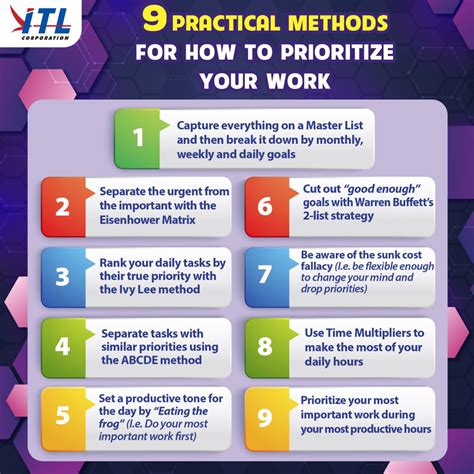In today's rapidly changing business landscape, organizations across industries strive to optimize their operations and maximize their team's potential. To achieve sustainable growth and stay competitive, it is crucial to harness the productivity and efficiency of the workforce. This article presents valuable insights and powerful strategies to help you propel your team's performance to new heights, revolutionizing the way you work and empowering your employees.
Discover the art of fostering a dynamic and proactive work environment that encourages creativity, collaboration, and innovation. Learn how honing your leadership skills and effectively managing resources can drive productivity gains and increase operational efficiency.
Empowerment through effective leadership: A skilled leader possesses the ability to inspire and motivate their team to deliver exceptional results. By building strong relationships based on trust, communication, and transparent feedback, leaders can help employees unlock their potential. Cultivating a sense of ownership and providing guidance while delegating responsibilities equitably can foster a proactive and independent workforce.
Communication as a catalyst for success: Effective communication channels are the backbone of any successful organization. Encourage open dialogue, active listening, and idea sharing. This fosters a culture of collaboration, which in turn leads to enhanced problem-solving, increased innovation, and streamlined decision-making.
Create a Productive Work Environment

Achieving maximum efficiency and productivity in the workplace starts with creating an environment that cultivates optimal performance and motivation. By establishing a productive work environment, you can set the stage for increased output, improved focus, and enhanced collaboration amongst your team. Here are some strategies to help you create a work environment that fosters productivity.
1. Encourage Clear Communication Effective communication is essential for productivity. Encourage open and transparent communication within your team, allowing for clear and concise instructions, feedback, and collaboration. Ensure that all team members feel valued and heard, promoting a sense of trust and unity. | 2. Cultivate a Positive Atmosphere A positive work environment can significantly impact productivity. Foster a culture of positivity by recognizing and celebrating achievements, promoting a supportive and inclusive atmosphere, and encouraging a healthy work-life balance. This can boost morale, motivation, and overall job satisfaction. |
3. Provide Necessary Resources To maximize productivity, ensure that your team has access to the necessary tools, technology, and resources they need to perform their tasks efficiently. This includes providing adequate training, equipment, software, and any other resources required to complete their work effectively. | 4. Foster a Collaborative Environment Encourage teamwork and collaboration among your employees. Foster an environment where individuals feel empowered to share ideas, work together on projects, and provide support to one another. Collaboration can lead to enhanced creativity, problem-solving, and overall productivity. |
5. Minimize Distractions Identify and minimize potential distractions in the workplace that can hinder productivity. This may include creating designated quiet spaces, implementing policies to manage interruptions, and establishing guidelines for the use of electronic devices and social media during work hours. | 6. Encourage Continuous Learning Promote a culture of continuous learning and growth within your organization. Offer opportunities for professional development, training, and skill enhancement. This not only improves individual productivity but also contributes to the overall growth and success of the company. |
By implementing these strategies, you can create a productive work environment that fosters efficiency, encourages collaboration, and ultimately leads to improved productivity and success for your organization.
Set Clear and Achievable Objectives
In order to maximize productivity and efficiency in the workplace, it is essential to establish clear and attainable goals for both individuals and teams. These objectives act as guiding beacons, providing employees with a sense of direction and purpose. By setting targets that are specific, measurable, actionable, relevant, and time-bound (SMART), organizations can empower their workforce to work towards common objectives.
Clarity: Clearly defined goals eliminate ambiguity and ensure that everyone is on the same page. When objectives are communicated clearly, employees can align their efforts towards achieving them.
Attainability: Setting realistic and achievable goals is crucial to maintaining motivation and avoiding feelings of overwhelm. Unrealistic goals can lead to frustration and demotivation, while attainable targets provide individuals with a sense of accomplishment as they make progress.
Alignment: Goals should be directly aligned with the overall mission and vision of the organization. When objectives are in line with the broader goals of the company, employees understand the importance of their work and are more likely to be motivated to achieve them.
Tracking Progress: Measuring and tracking progress towards goals allows for course correction and helps to identify areas where additional support or resources may be required. Regular check-ins and updates on progress can also serve as opportunities for recognition and celebration of achievements.
Time-Bound: Setting target deadlines for goals provides a sense of urgency and ensures that tasks are completed in a timely manner. Time-bound objectives help individuals prioritize their workload and avoid procrastination.
Overall, by setting clear and attainable goals, organizations can foster a focused and motivated workforce that is committed to achieving desired outcomes. Effective goal setting is an essential component of workplace productivity and efficiency.
Prioritize and Manage Your Tasks

Effectively managing and prioritizing tasks is essential for maximizing workplace productivity and efficiency. By carefully organizing and prioritizing your tasks, you can ensure that important deadlines are met, resources are utilized optimally, and overall productivity levels are boosted.
Set Clear Objectives: Begin by clearly defining the objectives and goals associated with each task. This will provide a clear direction and help you stay focused on what needs to be accomplished.
Identify Key Priorities: Determine which tasks are the most critical and prioritize them accordingly. Focus your time and energy on the tasks that will have the greatest impact on your overall productivity and success.
Create a Task List: Develop a comprehensive task list that includes all the activities that need to be completed. This can help prevent important tasks from slipping through the cracks and ensure that everything is accounted for.
Delegate When Possible: If certain tasks can be delegated to others, consider doing so. Delegating tasks not only frees up your time to focus on more important responsibilities but also helps develop the skills and capabilities of your team members.
Utilize Time Management Techniques: Employ effective time management techniques, such as the Pomodoro Technique or the Eisenhower Matrix, to prioritize and allocate your time efficiently. By managing your time effectively, you can avoid getting overwhelmed and increase your overall productivity.
Minimize Distractions: Identify and minimize potential distractions in your work environment. This can include turning off notifications, closing unnecessary tabs or apps, and creating a designated workspace that promotes focus and concentration.
Review and Adjust: Regularly review your task list, assess your progress, and make necessary adjustments. This allows for flexibility and ensures that you are continually working towards your goals in the most efficient manner.
Take Breaks: Schedule regular breaks throughout the day to recharge and rejuvenate. Taking short breaks can help prevent burnout and increase overall productivity by allowing you to maintain focus and energy.
By implementing effective task prioritization and management strategies, you can enhance workplace productivity and efficiency, ultimately leading to increased success and satisfaction in your professional endeavors.
Cultivate Effective Communication
Effective communication is vital for enhancing collaboration and efficiency within a workplace. It involves the clear and concise exchange of information, ideas, and feedback among team members, departments, and leadership. By fostering effective communication, organizations can overcome challenges, minimize misunderstandings, and build stronger relationships among employees.
Encouraging Active Listening: An important aspect of effective communication is active listening. This involves giving full attention to the speaker, understanding their perspective, and responding appropriately. By actively listening, individuals can clarify information, address concerns, and promote a culture of respect and understanding.
Embracing Open and Honest Dialogue: Creating an environment where employees feel comfortable sharing their thoughts and opinions is key to effective communication. Encouraging open and honest dialogue allows for the free flow of ideas, encourages innovation, and helps to identify and address any potential issues or conflicts promptly.
Utilizing Various Communication Channels: Different communication channels offer unique benefits and should be utilized based on the nature of the message. While face-to-face meetings and discussions enable real-time interaction and immediate feedback, email and messaging platforms provide a written record and allow for asynchronous communication. Utilizing different channels effectively ensures clear and timely communication across the organization.
Providing Constructive Feedback: Regularly providing constructive feedback to employees is vital for their growth and development. Feedback should be specific, actionable, and focused on improving performance. By providing feedback in a constructive manner, organizations can enhance individual and team productivity while also building trust and fostering positive relationships.
Recognizing Non-Verbal Communication: Effective communication extends beyond verbal interactions. Understanding and interpreting non-verbal cues such as body language, facial expressions, and tone of voice helps to better comprehend the underlying messages. By recognizing and responding appropriately to non-verbal communication, organizations can avoid misinterpretations and promote clearer understanding.
Creating a Culture of Transparency: Transparency is crucial for effective communication within a workplace. By openly sharing information about company goals, strategies, and decisions, employees feel valued and included. This helps to foster trust, strengthen commitment, and encourages collaboration for improved productivity and efficiency.
Embracing Cultural Diversity: In multicultural workplaces, embracing cultural diversity enhances effective communication. Being aware of cultural differences, promoting inclusivity, and adapting communication approaches accordingly fosters understanding and cooperation among diverse team members. By embracing cultural diversity, organizations can tap into unique perspectives and experiences, leading to enhanced creativity and problem-solving.
Embrace Technology and Automation

Incorporating the latest advancements in technology and embracing automation can significantly enhance efficiency and productivity in the workplace. By leveraging modern tools and streamlining manual processes, businesses can optimize operations and achieve greater outcomes.
Utilize cutting-edge software solutions:
Adopting innovative software applications tailored to specific tasks can revolutionize the way work is done. From project management tools that facilitate collaboration and task allocation, to customer relationship management systems that streamline communication and enhance sales processes, leveraging software solutions can greatly improve overall productivity.
Automate repetitive tasks:
Identify repetitive and time-consuming tasks that can be automated and replaced with technology. By implementing automated systems, such as data entry tools or workflow automation software, organizations can free up valuable time and resources, allowing employees to focus on more strategic and creative endeavors.
Emphasize communication technologies:
Investing in efficient communication tools is fundamental for boosting productivity. Utilizing instant messaging platforms, video conferencing software, and project management systems can facilitate seamless collaboration and enhance team coordination, regardless of physical location.
Implement cloud-based solutions:
Moving data and processes to the cloud can offer numerous benefits, including improved accessibility, enhanced data security, and increased efficiency. Cloud-based solutions enable remote access to important files, collaboration in real-time, and automated backups, ensuring seamless workflow and productivity.
Continuously invest in technology:
To stay ahead of the competition and remain efficient, it is important to keep up with the latest technological advancements. Regularly assessing and investing in new tools and technologies can help businesses optimize their operations, reduce errors, and drive productivity.
Embracing technology and automation is crucial for staying competitive in today's rapidly evolving business landscape. By leveraging the power of modern tools and streamlining processes through automation, organizations can enhance productivity and overall efficiency, ultimately achieving their goals more effectively.
Encourage Collaboration and Teamwork
Promoting a culture of collaboration and teamwork can greatly enhance the productivity and efficiency of a workplace. By fostering an environment where individuals can work together towards shared goals, organizations can harness the collective knowledge and skills of their employees to achieve optimal results.
One effective way to encourage collaboration is to establish open lines of communication among team members. This can be achieved through regular team meetings, brainstorming sessions, and the use of collaborative tools and platforms. By creating opportunities for employees to share ideas, exchange feedback, and collaborate on projects, organizations can foster a sense of unity and harness the power of collective thinking.
In addition to open communication, creating a supportive and inclusive work environment is essential for promoting collaboration. Encouraging team members to respect and value each other's opinions and contributions can foster a sense of belonging and motivate individuals to work together towards common goals. Leaders can also promote collaboration by providing opportunities for team building activities or team-based projects, which can help employees develop trust, improve communication, and enhance their ability to work effectively as a team.
Another effective strategy is to promote the sharing of knowledge and expertise among team members. Encouraging employees to mentor and help each other can foster a culture of continuous learning and growth. This not only enhances individual skill development but also improves team performance as a whole. Organizations can facilitate knowledge sharing through platforms like internal wikis, forums, or regular knowledge-sharing sessions, where employees can exchange insights and best practices.
Celebrating teamwork and recognizing collaborative efforts is also crucial in fostering a culture of collaboration. By publicly acknowledging and rewarding individuals or teams that exemplify strong collaboration and achieve collective goals, organizations can reinforce the importance of teamwork and motivate others to follow suit. This can be done through team-based incentives, recognition programs, or public appreciation events.
In conclusion, by encouraging collaboration and teamwork, organizations can tap into the collective potential of their employees and boost workplace productivity and efficiency. Creating an environment that promotes open communication, inclusivity, knowledge sharing, and recognition of collaborative efforts can foster a culture of collaboration that drives success.
Focus on Employee Well-being and Achieving Work-life Balance

In order to optimize the overall performance of your workforce, it is essential to prioritize the well-being of your employees and foster a healthy work-life balance. Concentrating on the physical, emotional, and mental health of your team members can greatly contribute to their productivity and efficiency. By providing support and resources for maintaining a balanced lifestyle, you can create an environment where employees feel valued, motivated, and empowered to perform at their best.
One way to enhance employee well-being is by encouraging regular breaks and promoting a positive work environment that enables individuals to recharge and rejuvenate. Taking short breaks throughout the day allows employees to manage their energy levels effectively and prevents burnout.
Additionally, promoting a culture that emphasizes work-life balance enables your team members to prioritize personal commitments and responsibilities alongside their professional duties. Encouraging a healthy integration of work and personal life helps individuals manage stress and maintain high levels of productivity, as they feel supported in achieving a harmonious equilibrium between the two.
Supporting employee well-being can also be achieved through providing access to resources and initiatives that nurture physical health. Implementing wellness programs, offering gym memberships or recreational facilities, and providing healthy snack options can contribute to the overall physical well-being of your employees, boosting motivation and energy levels.
Creating an inclusive and supportive work environment that encourages open communication is also crucial for employee well-being. By fostering a culture where employees feel comfortable discussing their concerns and seeking assistance, you can address any potential issues early on and offer the necessary support to maintain their mental and emotional well-being.
In conclusion, prioritizing the well-being of your employees and promoting work-life balance leads to increased productivity and efficiency in the workplace. By investing in the physical, emotional, and mental health of your team members, you create an environment that fosters their overall well-being and allows them to thrive both personally and professionally.
FAQ
What are some practical ways to increase workplace productivity?
There are several practical ways to increase workplace productivity. One effective strategy is to prioritize tasks and create a to-do list, which helps in staying organized and focused. Another tip is to minimize distractions by turning off notifications or finding a quiet space to work. Regular breaks can also be helpful in maintaining productivity, as they prevent burnout and allow for mental rejuvenation. Additionally, delegating tasks, setting clear goals, and utilizing time management techniques can contribute to increased efficiency.
How can I manage my time effectively at work?
Time management is crucial for productivity at work. One method is to create a schedule and prioritize tasks based on urgency and importance. Avoiding multitasking and focusing on one task at a time can also help in managing time effectively. Setting specific blocks of time for certain activities and eliminating time-wasting activities like excessive social media use can improve productivity. Additionally, learning to delegate tasks and seeking assistance when needed can free up time for more important responsibilities.
Is it beneficial to encourage teamwork in the workplace?
Encouraging teamwork in the workplace is highly beneficial for productivity and efficiency. When employees collaborate and work together towards a common goal, tasks can be completed more efficiently. Teamwork also encourages creativity, problem-solving, and mutual support among team members. Effective communication and division of tasks within a team can streamline workflow and result in better outcomes. Overall, teamwork fosters a positive work environment and enhances overall productivity.
What role does workplace environment play in productivity?
The workplace environment plays a significant role in productivity. A clean, organized, and well-designed workspace can enhance focus and concentration. Natural lighting, proper ventilation, and comfortable furniture contribute to employee well-being and productivity. Additionally, creating a positive and supportive work culture, where employees feel valued and motivated, can significantly impact productivity levels. Regular feedback, recognition of achievements, and fostering a sense of camaraderie among employees can also boost workplace productivity.
How can I improve my personal efficiency at work?
To improve personal efficiency at work, it is important to identify and focus on one's strengths and weaknesses. Prioritizing tasks, setting realistic goals, and breaking them down into manageable steps can increase efficiency. Developing good organizational skills, such as maintaining a tidy workspace and keeping track of deadlines, is also beneficial. Additionally, staying updated with relevant skills and technologies, practicing effective time management, and seeking continuous improvement through learning and feedback can help improve personal efficiency at work.



